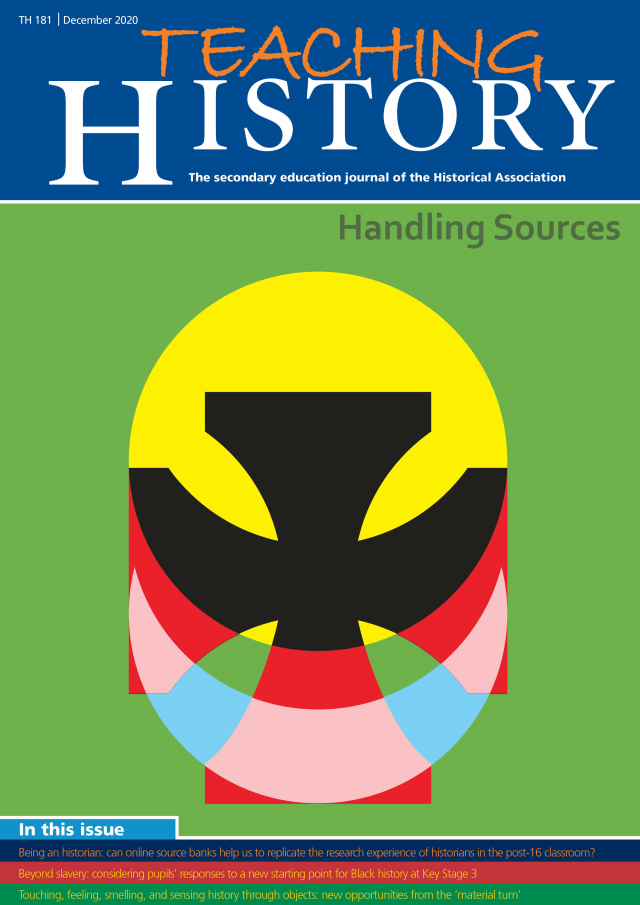Teaching History 181: Out now
The HA's journal for secondary history teachers

Editorial: Handling Sources
While 2020 will go down in history as the year of the coronavirus pandemic, those who teach history may also remember this year for the impetus that it gave to calls for curriculum change. Petitions to the UK parliament demanding ‘compulsory teaching of Britain’s colonial past’ and greater inclusion of ‘BAME history’ together attracted nearly 300,000 signatures. In such circumstances it might seem perverse to publish a second issue of Teaching History focused less on the content of the school history curriculum than on questions about how historical knowledge is constructed; following September’s theme of ‘How history works’ with this look at ‘Handling sources’. Yet the range of content addressed by the articles in this issue makes it clear that consideration of how valid claims about the past are constructed using sources as evidence also prompts reflection on the questions asked about the past and the kinds of sources used to answer them.
We cannot focus students’ attention on the processes used by historians without also considering which particular historians to introduce to our students as models of the practice in action. In broadening the scope of our history curriculum or changing the perspective from which we study aspects of the past, we almost certainly need to develop our own substantive knowledge, drawing on new historical scholarship. But we also need to familiarise ourselves with new kinds of source material and new methods for interrogating it.
As we introduce young people to those methods, we also need to be sure about why we are inviting our students to adopt the role of an historian. While such an invitation can build young people’s sense of self-efficacy, encouraging them to join in debates about the past and its implications for their present, it does not reflect an assumption that they will thereby be generating ‘new public knowledge’. As Husbands has explained, its value lies instead in the ‘new private understandings’ that young people develop. As they learn to relate previous contextual knowledge to particular traces of the past in response to specific historical questions, and to formulate valid historical inferences, so they come to understand how others’ claims have been constructed and how they can be effectively evaluated.
Too often, however, work with sources in history classrooms is driven less by an awareness of what historians do and more by the constrained ways in which sources are represented in public examinations. Robin Conway and Amy Scott sought to redress this balance with their A-level students, eschewing formulaic exam preparation based on pre-selected extracts in favour of extensive use of online archives. Their article demonstrates how this attempt to replicate more closely the experience of academic historians led to significant improvements both in students’ enjoyment and in their capacity to interpret sources effectively.
Abdul Mohamud and Robin Whitburn focus on the start of the secondary curriculum, considering students’ first encounter with history in Year 7. In many schools this takes the form of an introductory unit – ‘What is history?’ – in which students are initially invited to assume the role of a modern detective piecing together clues about a mysterious death. While keen to involve students in using traces of the past to develop and substantiate their own hypotheses, the teachers with whom Mohamud and Whitburn worked believed that such a unit could also achieve other significant objectives if its focus were switched from a fictional scenario to the history of Africa and the early establishment within the continent of both Christianity and Islam. As they taught students how to draw inferences from diverse sources (including artefacts and surviving buildings), the teachers also deliberately sought to introduce students to the work of African historians, illustrating both their methods and the ways in which their studies inspired them.
Teni Oladehin was similarly inspired to review how Black history was introduced to her students at Key Stage 3, seeking to ensure that it would be addressed within an ‘authentic’ narrative that brought Black agency to the fore. Her article shows how an enquiry examining the significance of Mansa Musa built her students’ knowledge of precolonial African history. While Oladehin’s attention was focused on the benefits for all young people of addressing important misconceptions that otherwise may come to be held about Africa’s past, Tessa McLaughlin’s ‘Cunning Plan’ provides considerable support for teachers keen to develop their own knowledge of the kingdom of Mali and its mansas (kings) and of the particular sources from which accounts of the kingdom’s history have been constructed.
Michael Bird and his co-authors also sought to expand the range of historical sources with which young people work. Focusing on the recent ‘material turn’ in historical scholarship, their article explores how students can engage directly with the ‘everyday’ objects of medieval life. Bird and his colleagues worked with museum curators and trainee teachers to bring previously overlooked items from local history museums into schools. Their article shows how carefully-structured support as students handled the objects created an inclusive and absorbing learning environment. A sense of respect, engendered by the authenticity of the objects, gave rise to highly productive forms of speculation, appropriately tempered by contextual knowledge.
The final article by Jonathan Sellin offers a salutary warning about the need to examine the ideas that our students actually hold about the processes in which historians engage, rather than assuming that they have all come to understand those processes in the ways that we intended. Asking students to create drawings of historians’ methods alerted Sellin to the fact that many of his students continued to hold important misconceptions about their work or struggled to apply general principles to specific historical questions. His investigation made him reconsider his use of sources in the classroom, making him more determined to tackle unhelpful assumptions and to model historians’ use of sources much more regularly.

